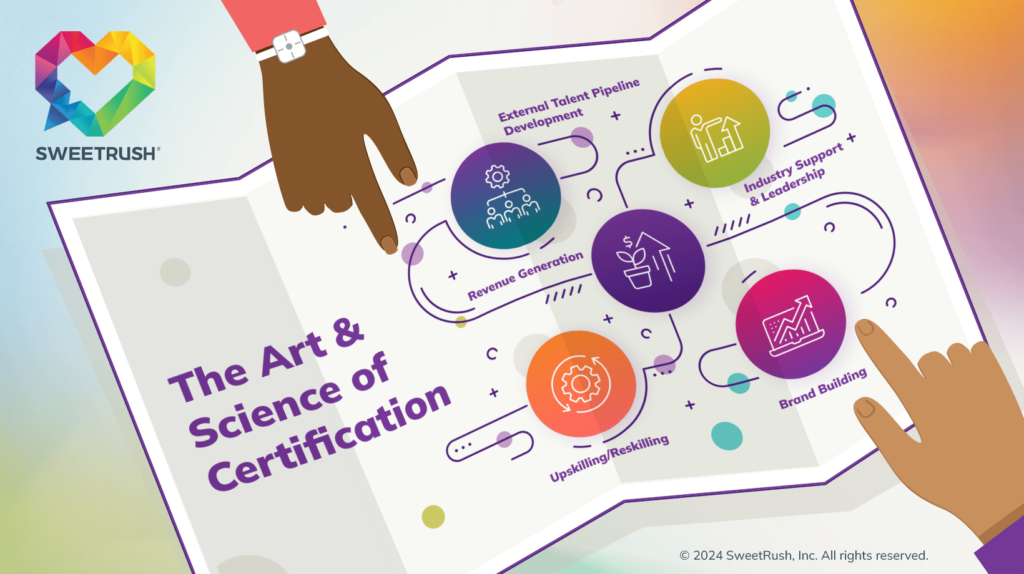The Certification Advantage: Skilling Programs for the Future of Work

Certification programs are helping people and businesses thrive amid rapid change. Discover the art and science underlying this powerful approach to skill development.
Back in 2022, our research showed that skills are a top organizational priority—and that was no post-COVID blip.
Since then, the need to flex in response to an increasingly volatile, uncertain, complex, and ambiguous (VUCA) economy and environment has only become more urgent. That need has manifested in our collective approach to skilling.
Organizations have been taking inventory of the skills they have in-house and the skills they need to meet the changing demands of work and achieve long-term viability. Meanwhile, the half-life of knowledge is shrinking—meaning the skills we learn today might not be relevant in just a few years.
Shoring Up Skills
Small wonder that L&D professionals have been under pressure to get people onboarded, upskilled, and productive—and faster than ever.
As one L&D leader shared in 2024, “The world is changing quite rapidly (more than in human history) and the shape of business, how we work together, and how work gets done are all shifting in critical ways.
Not only do we need the technical skills to make the right strategic decisions for our businesses, but we need the human empathy and leadership skills to be able to lead others to grow successfully both personally and professionally.“
Certification: Skilling Programs for the Future of Work
To meet the need for strategic skills growth in our wildly VUCA world, some of the most future-focused L&D leaders and teams are turning to certification programs. Certification programs help them develop a common language for skilling that is mutually intelligible across business units, organizations, and entire industries.
By developing a certification program, you can equip your people with the precise skills needed to meet today’s demands—and continue growing tomorrow. From the learners’ perspective, a certification provides a fast, effective way to validate their expertise and signal to employers that they’re staying ahead of the skilling curve.
The Art and Science of Certification: Highlights from Our Live Webinar
In our recent webinar, our in-house certification program development experts Annie Hodson, Jane Fairchild, and Katie Peonio shared some of the needs and vision that led four world-class skills organizations to create their own certification programs–complete with an exclusive look into their design and development process.
Naturally, we received plenty of insightful audience questions, ranging from use cases to learning modalities. See below for a recap:
What’s the connection between SweetRush and the four skills-focused organizations presented in the webinar?
We’re proud partners! SweetRush is a learning agency that joins forces with clients across a range of industries to provide thought partnership, learning strategy, expertise from a deep bench of SMEs, and learning solution design and development described in all four certification programs. We partner with most organizations from the very beginning—assessing needs, ideating on possibilities, and supporting our clients all the way through program launch. But we can also step in to augment a client’s current capacities, as we did with Intel.
I love that you use a team approach that best utilizes each professional’s skills. I am dismayed to be seeing a move away from this in our industry. Do you see that too? What are your thoughts on the one-person-does-all trend?
We know a few of these one-person bands! They manage their own projects, develop their own learning solutions, create their own graphics, and manage their own technology.
Our take is that the right approach = the right talent and the right team for each project.
Certification program development is a massive undertaking—encompassing 13 hours of learning at the shorter end to 100 hours or more. When we’re working on such a large scale, we find that having specialized talent helps each of us work in our area of expertise, thus contributing to overall efficiency as a team.
But we also have clients who come to us with more modest certification needs: say, an eLearning course or an ILT. If the content is stable and the solution is needed on a relatively short timeline, engaging just one or two people can help the project proceed more efficiently.
We think of ourselves as matchmakers for the project needs and for each client’s culture, team, and business. Intel, for example, has a robust internal learning team that had already developed the internal version of their certification program; they just needed some extra help to prepare it for external use.
How can you tell when you need a certification program? Is it the amount or complexity of skills content? Hiring needs?
There are a variety of factors that might indicate a certification program is the right solution! Here are a few:
You want to align a complex training experience with an end goal in mind, your industry requires a certificate or both.
It’s empowering to learners to know that their training will culminate in a certificate validating that they have a given skill set. Their certificate allows them to share their expertise and skills currency with prospective employers and grow their careers.
You want to uplift the standard of practice in your industry. We often work with industry associations, like the Society for Human Resource Management (SHRM), as well as medical associations and nonprofit organizations, who want to support their industry with upskilling programs. These certifications are typically quite robust and have a large volume of content around these specialized skills and topics…though we are seeing a trend of some mini-certification programs!
I work with an organization that wants to develop and sell a certification program, but we’re not sure how to host it and market it. How do we figure that out?
First, let’s review the range of distribution strategies:
Internal distribution: This is the most common situation: An organization develops a certification program and offers the program to its own people through its LMS.
External sales: Developing a certification program to sell and monetize makes distribution slightly more complex. An organization might host the program on its own LMS, with the help of a payment platform that enables learners to pay online and secure immediate access. This strategy works well for organizations like SHRM, who are already well-known within their industry and have robust marketing and communication channels. For organizations that don’t have immediate access to such a large learner base and are trying to expand, working with a larger organization–for example, our client-partner Coursera–can provide access to a broader learner audience.
External white-labeling: This option involves developing a certification program and selling it to other organizations, who then add their own branding and distribute it to learners via their organizations’ LMS platforms.
Each of these distribution models has its own challenges, complexities, and rewards. If you’re considering a certification program, we’re always happy to help you think through your process, strategy, marketing and communications campaign, and go-to-market plan.
How long does it take to develop a career certification program?
There are numerous factors that affect the design and development timeline of a certification program. If you’re looking at a single course or a smaller-scale program, the process could take no more than a couple of months. Larger-scale programs might take six to nine months; however, we have some creative ways to launch these. Depending on the content volume and how stable it is, a staggered launch might be a possibility.
The design and development timeline also depends on whether we opt for a team approach or a one-person band. We can also strategically augment existing teams to reduce the time to launch.
How many hours is a typical certification program?
We hate to fall back on the phrase numerous factors again, but it depends on the volume of learning objectives we define with the client and the metrics used to assess learner competency and success. The amount of content and size of the team also play a role: We’ve created certification programs that range from a few hours to approximately 100, with teams ranging from a one-person band to an entire orchestra.
If you don’t have access to a psychometrician, where would you advise getting an overview of psychometric best practices?
For an overview of a psychometrician’s role and what it means for your certification program or learning solution, we recommend checking out this Q&A with our resident psychometrician, Barbara Rowan. Partners like eLearning Industry, Training Industry, and Chief Learning Officer also have numerous measurement and evaluation resources available–including blog posts, webinars, and eBooks–that can help you gain a better understanding of the nature and value of psychometrics.
If you need a psychometrician or someone with any very specialized skill set, we’re happy to start the conversation with that perfect-fit SME, consultant, or temporary team member.
What kinds of learning modalities should be used in a certification program?
It depends! Depending on whether the program will be delivered online, in-person, or in a blended-format delivery, a range of modalities can be used to meet performance objectives. From video-based instruction to simulations, eLearning featuring storytelling and interactivity, practical hands-on projects, and strategies, a well-chosen collection of modalities can help to bridge the gap between learning and daily work.
To that end, we like to incorporate as many simulations as possible into certification programs—particularly those leveraging WebXR, a web-based virtual reality technology accessible via VR headsets or mobile devices. WebXR simulations invite learners into a 360-degree immersive environment that challenges them to practice skills in authentic, immediate settings and situations while receiving real-time feedback.
Lately, we’ve been especially excited about incorporating AI into text-messaging and conversational simulations to help learners practice soft skills related to customer service, management, and de-escalation. Ultimately, any choice of modalities should be driven by learning needs and skilling requirements. Like a constellation, no two certification programs are exactly the same.
What is the best way to get learners excited about new certificates?
Sometimes, a great topic itself can drive excitement: Coursera’s “Introduction to the Metaverse” certification program comes to mind! We knew that this buzzy topic would generate interest, and we ensured that the content was as engaging and thought-provoking as the title.
Engaging “celebrity SMEs” to present videos—and even serve as AI avatars—can also help to generate excitement, especially for emerging areas of interest and study.
Finally, leading with the WIIFM (What’s in it for me?) engages learners by presenting a vision of success at the finish line. Whether the certification program can help them level up in their career, make sales, build relationships, or make a career switch, working toward real-world application is energizing and motivating. In our experience, a certification program that encourages learners to create a portfolio they can leverage for future work opportunities also helps to generate excitement.
Got a skilling need that just might add up to an epic certification program? Let’s talk!
The post The Certification Advantage: Skilling Programs for the Future of Work appeared first on SweetRush.







